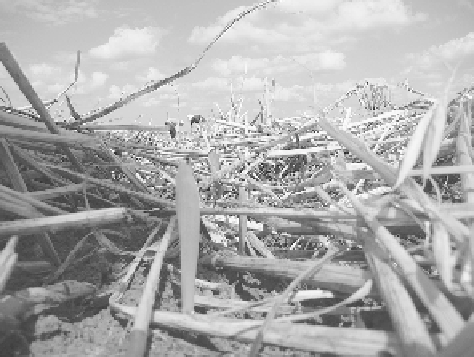Agriculture Reference
In-Depth Information
Land prone to erosion is often managed by conservation agriculture, the main
principles of which are to prolong permanent plant or residue cover, to use diverse
crop rotations, to minimize soil disturbance, and to leave crop residues at the surface.
An important component of this is the use of conservation tillage (either no-tillage
or minimum tillage) instead of plowing. In no-tillage, the seeds are drilled directly
into the soil under the residues of the previous crop, which protect the seedlings
(Figure 11.2). Minimum tillage uses some shallow fixed blade or disc cultivation
before sowing the seeds.
Conservation tillage uses less machinery and fuel than normal plowing but
depends heavily on weed control by chemicals and demands high standards of man-
agement. It is extensively used in Brazil and Australia, but its continued use is threat-
ened by a buildup of soil compaction.
Perennial crops perhaps offer the ultimate potential for large-scale conservation
agriculture. Unlike most crops, the land needs no regular tillage because they do not
need to be resown every year. Cox (2008) claims that a field of perennial grain crops
would provide food while conserving soils and water and reducing inputs of fertil-
izers, chemicals, and fuel.
Smaller-scale conservation agriculture methods that may help develop sustain-
ability include the reuse of old farming systems where land was shared and farmed
in small parcels such as crofts or allotments and that help in growing more local
food crops. More novel systems include agroforestry. For example, in India, wheat
is grown for food among poplar trees, which capture carbon in the wood, the roots,
and the soil.
The ultimate aim of agricultural sustainability would be to develop less inten-
sive small-scale farming systems that are very similar to natural ecosystems and
that match local conditions or resemble gardens. Multiple cropping in the same
field or garden is common in some smallholder farming systems. This encourages
FIGURE 11.2
Greening power. Maize seedling emerges from under the protection of the
residues of the previous crop in Brazil. (Photo courtesy of Dr. Neyde Fabiola, Universidade
Estadual de Ponta Grossa, Brazil.)

Search WWH ::

Custom Search